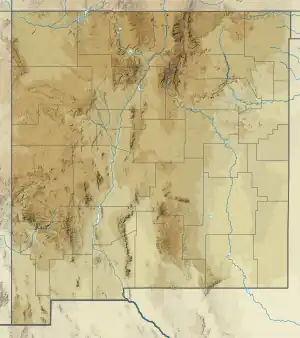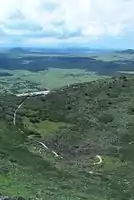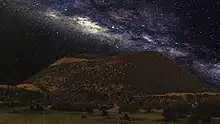Capulin Volcano National Monument
Capulin Volcano National Monument is a U.S. National Monument located in northeastern New Mexico that protects and interprets an extinct cinder cone volcano and is part of the Raton-Clayton volcanic field. A paved road spirals gradually around the volcano and visitors can drive up to a parking lot at the rim of the extinct volcano. Hiking trails circle the rim as well as lead down into the mouth of the volcano. The monument was designated on August 9, 1916, and is administered by the National Park Service. The volcano is located 5 kilometres (3.1 mi) north of the village of Capulin.
| Capulin Volcano National Monument | |
|---|---|
 Last erupted between 55,000 to 62,000 years ago[1] | |
  | |
| Location | Raton-Clayton Volcanic Field, Union County, New Mexico, New Mexico, United States |
| Coordinates | 36°46′56″N 103°58′12″W |
| Area | 793 acres (321 ha)[2] |
| Elevation | 2,494 m (8,182 ft) |
| Max. elevation | 8,182 |
| Authorized | August 9, 1916 |
| Visitors | 67,442 (in 2018)[3] |
| Governing body | Department of the Interior |
| Website | Capulin Volcano National Monument |
The visitor center features exhibits about the volcano and the area's geology, natural and cultural history, and offers educational programs about volcanoes. There is also a video presentation about the volcano. The name capulin comes from a type of choke cherry, Prunus virginiana, that is native to North America.
Apollo 16's John Young and Charlie Duke did some of their geologic training here in May 1971. William R. Muehlberger was one of the geology instructors.[4]
Description
From the National Park Service:[1]
Capulin Volcano National Monument is a well-preserved, relatively young (55,000 to 62,000 years old), symmetrical cinder cone. It rises steeply from the surrounding grassland plains to an elevation of 8,182 feet above sea level. The irregular rim of the crater is about a mile in circumference and the crater about 400 feet deep.
Capulin Volcano is one of the outstanding landmarks located in the northeast corner of New Mexico, where the rolling grasslands meet the foothills of the Sangre de Cristo Mountains. Capulin Volcano's highest point provides unobstructed, panoramic views of the volcanic field, distant snow-capped mountains, and portions of five states (New Mexico, Oklahoma, Kansas, Texas and Colorado).
Capulin Volcano also offers visitors excellent opportunities for observing and understanding volcanic formation. The large volcanic field surrounding the monument contains at least 100 recognizable volcanoes, and aids visitors in gaining insights into 10 million years of the geological history of northern New Mexico.
 The grass-covered outer slope of the cinder cone.
The grass-covered outer slope of the cinder cone. A trail leads from the parking lot to the crater floor.
A trail leads from the parking lot to the crater floor. View from the summit.
View from the summit. A satellite image of the volcano (center) and the surrounding area
A satellite image of the volcano (center) and the surrounding area Looking south southeast from the walking path encircling the volcano.
Looking south southeast from the walking path encircling the volcano.

Visitor activities


The two mile road that winds from the bottom of the volcano all the way to the top is popular with visitors. Once the top is reached, views of the surrounding volcano field, Sangre De Cristo mountains, the flora and fauna are visible. From late June to early August a phenomenon called hilltopping can be seen on the Crater Rim trail, thousands upon thousands of ladybugs cover trees and bushes at the top of the volcano. Capulin is also International Dark-Sky Association Gold Tier Certified, which means it has one of the darkest night skies in the entire country. Due to low levels of light pollution incredible views of the Milky Way and constellations are evident.
Visitors can hike a variety of different trails located throughout the park. The Lava Flow trail is a mile long loop that runs along the southern portion of the park. The Boca Trail is a 1.7 mile long loop that runs along the western base of the volcano, hikers can view the collapsed lava tubes that were created thousands of years ago at the foundation of the volcano. There are two different trails accessible from the top of the volcano: the Crater Rim trail which is a one-mile loop that goes around the entirety of the rim of the volcano and the Crater Vent trail which goes 200 yards into the crater itself.[5]
History
According to the National Park Service,[5] on January 16, 1891, Capulin Mountain was
...withdrawn from settlement, entry or other disposition under any of the public land laws, until such time as Congress may see fit to take action touching the same or until otherwise ordered by competent authority...
On August 9, 1916, President Woodrow Wilson set Capulin aside as a U.S. National Monument by Presidential Proclamation No. 1340, to preserve "...a striking example of recent extinct volcanoes ... which ...is of great scientific and especially geologic interest..."
Jessie Foote Jack and other local ranchers highly valued Capulin Volcano during this time period as it was considered prime grazing land.[6] In order to ensure sole rights to graze cattle on the volcano, Jessie used her husband's political connections to secure the position of custodian for the monument. Serving from 1916 to 1921, Jessie Foote Jack was the first custodian for Capulin Volcano, as well as the first female custodian in the National Park Service.
In 1921, Homer Farr would unofficially become the custodian of the monument at the request of Mrs. Jack. Later, in 1923, Farr would officially take over the position serving the National Park Service until 1955. His enthusiasm for the volcano brought numerous changes to the monument. During his tenure, Farr was credited with building the monument's infrastructure which includes the road to the rim, procuring funding in economically difficult times, and garnering a Civil Works Project during the Great Depression to stabilize the road and build retaining walls.[7]
Public Law 87-635, 87th Congress, S.2973, September 5, 1962, amended the proclamation to "...preserve the scenic and scientific integrity of Capulin Mountain National Monument..." because of the significance of Capulin Volcano.
On December 31, 1987, Congress changed the Monument's name from Capulin Mountain National Monument to Capulin Volcano National Monument by Public Law 100-225 (101 Stat. 1547).
 Congealed lava flows, viewed from the top of Capulin Volcano (1909)
Congealed lava flows, viewed from the top of Capulin Volcano (1909) Capulin Volcano, viewed from the west (1916)
Capulin Volcano, viewed from the west (1916) Homer Farr after the completion of the road (1925)
Homer Farr after the completion of the road (1925)
Ecology
.jpg.webp)
Although Capulin is primarily known for its volcanic geology, the park boasts a rich diversity of plant and animal life. The grasslands of the Great Plains and the forests of the Rocky Mountains combine at Capulin to form a unique ecotone which provides habitat for 73 species of birds in addition to numerous other animals.[8] Songbirds such as the spotted towhee, Bullock's oriole, mountain bluebird, and Steller's jay all call Capulin Volcano home. Larger birds such as the wild turkey, osprey, red-tailed hawk, as well as New Mexico's state bird, the roadrunner, also live within the park. There are five different species of hummingbird that migrate through Capulin during the summer months.
Some of the larger mammals that frequent the park include the American black bear, cougar, pronghorn, elk, and the most numerous of larger mammals, the mule deer. Smaller mammals such as the American badger, Mexican free-tailed bat, ring-tailed cat, desert cottontail, and North American porcupine also inhabit Capulin Volcano National Monument. The unique landscape and flora create a habitat that allows a large and diverse group of animals to co-exist in a relatively small area. The abundance of diversity is not contained to just warm blooded animals however, Capulin also has a large group of cold blooded reptiles as well. The prairie rattlesnake and bullsnake are seen throughout the park. Western fence lizards and horned lizards can be seen on hiking trails. The tiger salamander is found in pools of water that sometimes collect around the park.
Solidago capulinensis, known as the Capulin goldenrod, is a rare plant endemic to Capulin Volcano National Monument. It is the only known rare vascular plant species in the monument.[9]
See also
- List of national monuments of the United States
- Black Mesa (Oklahoma) to the northeast
- Eastern New Mexico
- Johnson Mesa to the northwest
- Sierra Grande to the southeast
References
- National Park Service. "Geology". Capulin Volcano. Retrieved 25 October 2009.
- "Listing of acreage – December 31, 2011" (XLSX). Land Resource Division, National Park Service. Retrieved 2012-03-12. (National Park Service Acreage Reports)
- "NPS Annual Recreation Visits Report". National Park Service. Retrieved 2018-04-18.
- Phinney, William (2015). Science Training History of the Apollo Astronauts. NASA SP -2015-626. p. 246.
- National Park Service. "History & Culture". Capulin Volcano. Retrieved 25 October 2009.
- "Jessie Foote Jack". National Park Service. Retrieved 5 May 2020.
- "Capulin Volcano". National Park Service. Retrieved 8 June 2019.
 This article incorporates text from this source, which is in the public domain.
This article incorporates text from this source, which is in the public domain. - "Nature - Capulin Volcano National Monument". U.S. National Park Service. Retrieved 2019-06-04.
-
 This article incorporates public domain material from Capulin Goldenrod. National Park Service.
This article incorporates public domain material from Capulin Goldenrod. National Park Service.
External links
- Official Capulin Volcano National Monument website—National Park Service
- Sangres.com: Information and photos
- Geology Fieldnotes: Capulin Volcano National Monument—National Park Service